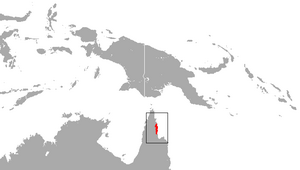Iron Ranges antechinus facts for kids
Quick facts for kids Cinnamon Antechinus |
|
|---|---|
| Conservation status | |
| Scientific classification | |
| Genus: |
Antechinus
|
| Species: |
leo
|
 |
|
| Cinnamon Antechinus range | |
The cinnamon antechinus (Antechinus leo) is a small, furry animal that lives in Australia. It's a type of marsupial, which means it carries its babies in a pouch, like a kangaroo! People also call it the Iron Ranges antechinus or the Cape York antechinus.
This special animal is only found in one small part of Australia: the Cape York Peninsula. It lives in forests around the McIlraith and Iron Ranges. The cinnamon antechinus is quite rare, just like its cousin, the Atherton antechinus.
Contents
Discovering the Cinnamon Antechinus
Scientists didn't officially describe the cinnamon antechinus until 1980. Before that, it was sometimes mistaken for other similar animals, like the yellow-footed antechinus or the Atherton antechinus.
This antechinus belongs to a family of animals called dasyurids. The word leo in its scientific name, Antechinus leo, means "lion." This is because its fur is a beautiful cinnamon color, a bit like a lion's mane!
What Does It Look Like?
The cinnamon antechinus is one of the bigger antechinus species. It has more reddish-brown fur compared to its relatives. It gets its name from its lovely cinnamon-colored fur, though it also has a darker stripe down the middle of its head.
This animal is nocturnal, meaning it is most active at night. It also likes to live in trees, so it's called arboreal. The cinnamon antechinus enjoys eating different kinds of invertebrates, like insects and spiders.
Life Cycle and Reproduction
Like all antechinuses, the males of this species have a very unique and sad life cycle. After the breeding season, which happens in September, all the male antechinuses die. This allows the females to focus on raising their young.
Where Does It Live?
The cinnamon antechinus lives in a very small area on the Cape York Peninsula in Australia. It prefers to live in a type of forest called semideciduous rainforest.
Even though there might be many of them in their small home, their limited living space means they were once considered "near threatened." This means they needed to be watched carefully to make sure their numbers didn't drop too low. The IUCN keeps track of animals like this to help protect them.
See also
 In Spanish: Antequino canela para niños
In Spanish: Antequino canela para niños


